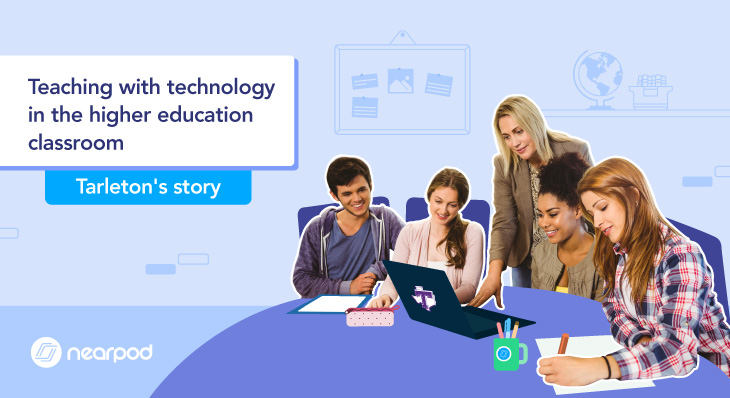
Teaching with Technology in the Higher Education Classroom
Like many schools during the 2020-2021 school year, Tarleton State University (TSU) in Stephenville, Texas had to pivot to a hyflex learning instruction model. The professors at TSU were prepared to make that shift thanks to the academic technology resources that had already been implemented into their classrooms before the pandemic started.
Dr. James Gentry, a professor and director of instructional development and course design at TSU, has invested years researching the different types of technology that can be used to enhance classroom instruction. Since arriving at TSU in 2005, he has placed a focus on how technology can be used in the higher education classroom. He feels strongly that it is important to not only use technology to enhance his instruction, but to prepare future K-12 educators to teach in technology-enhanced classrooms. As a member of Texas A&M’s Council on Academic Technology and Innovative Education (CATIE), he collaborates with his peers across the university system to learn how different forms of technology can be used in both classroom instruction and assessment. He also educates his colleagues at TSU on the best practices for integrating technology into their curriculum and instruction.
As a former K-12 educator, Dr. Gentry has seen how the thoughtful use of technology in the classroom has impacted student comprehension and engagement. He has also observed how technology has changed over the decades. He noted that when he first entered the classroom, his classroom’s technology consisted of a chalkboard and one computer for the entire class to share. He also remembers that if technology needed to be incorporated into a lesson for the entire class, they would utilize the school’s shared computer lab.
Nowadays, Dr. Gentry has students coming to his classroom with multiple forms of technology—cell phones, laptops, and tablets. He believes that all of these devices have the potential to engage his students in deeper, more meaningful ways. One way he adapted his instruction to accommodate such devices was by weaving Nearpod into his curriculum. He started using Nearpod in this classroom as a way to formally and informally assess students’ understanding of the content he was teaching.
Dr. Gentry’s background in education means that he understands that students learn in a variety of ways. With class sizes averaging around 30 students, he feels that Nearpod helps him to address all of the different learning styles in this classroom. He also finds the versatility of Nearpod’s features allows him to adapt his curriculum so that it is relevant for his undergraduate, graduate, and doctoral students.
“I wanted something easier.”
Dr. Gentry was impressed by how easy it was to add content and create new activities within Nearpod’s platform. Nearpod’s ability to integrate with Google Slides and the Canvas learning platform was also extremely appealing to him. He appreciates how easy it is to add videos and visuals such as charts or photographs that students encounter during their assigned readings into a lesson on Nearpod. By adding the visuals from their reading into a lesson in Nearpod, he is able to incorporate activities to assess students’ comprehension from the reading. Nearpod formative assessment tools such as polls, open-ended questions, and multiple choice questions allowed him to see student responses in real-time. His students that were less vocal during classroom discussions were more engaged and seemed to feel more comfortable sharing their opinions and ideas on Nearpod’s platform.
“Nearpod saved me during the pandemic.”
In the Spring of 2020, Dr. Gentry found himself in the same position that the majority of professors and instructors across the country were in. He was thankful that both he and his students were already comfortable using Nearpod before the pandemic started. However, he knew that the way he instructed his students remotely would look a little different. He also knew how important his role was in preparing future educators to enter into classrooms of their own, potentially spending their first year of teaching to students amidst a pandemic. He knew that in addition to building their confidence in curriculum and design, it was now also crucial to teach them how to instruct their future classrooms in hyflex or remote learning situations. He has made it a point to introduce his students to digital technology that they may encounter once they enter their own classrooms and are responsible for educating their own group of students.
When Dr. Gentry’s students transitioned to remote learning, he wanted to ensure that his students were still receiving the same level of instruction as they would have been getting when they were physically in the classroom. He relied on an old instructional method to engage students, which encouraged classroom discussion before, during, and after learning a new concept. This also allowed him to have a better understanding of what students understood before and after learning a new topic. He facilitated these types of discussions where students could share their ideas and opinions through Nearpod’s Collaborate Board feature.
Dr. Gentry believes that Nearpod is a much more affordable option compared to other digital learning platforms on the market. He also believes that Nearpod has much more to offer thanks to its integration with other tools such as Google Slides. Another benefit for him is that he and his students only need to manage one login to gain access to a multitude of resources.
With Nearpod, professors save time by streamlining their workflow to create and deliver interactive lessons with one singular platform. They can use this singular platform, instead of many, to find everything they need. It’s in Nearpod.

Nearpod’s award-winning platform is used by thousands of schools around the globe, transforming classroom engagement.

